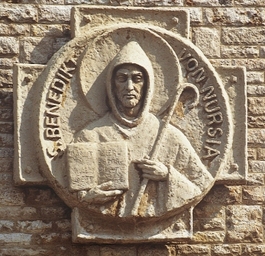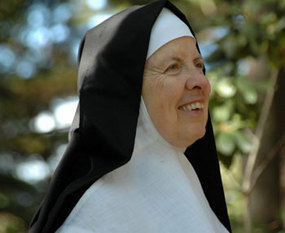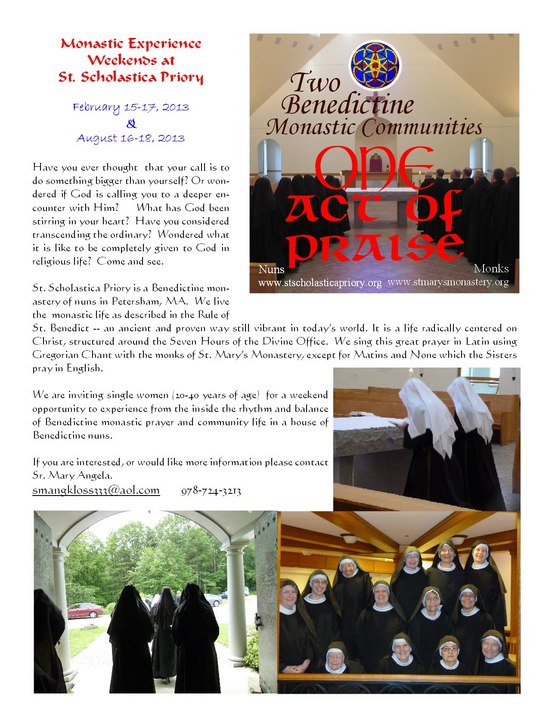 You can get a quick visit to Saint Meinrad’s Archabbey in 2 minutes via YouTube. David Yonke put together a very nice video with good images and music. Brother Francis de Sales Wagner posted the video on his delightful blog, The Path of Life.
You can get a quick visit to Saint Meinrad’s Archabbey in 2 minutes via YouTube. David Yonke put together a very nice video with good images and music. Brother Francis de Sales Wagner posted the video on his delightful blog, The Path of Life.
Tag: Benedictine
Church completes Benedictine merger: Subiaco Cassinese Benedictine Congregation
On Tuesday, 26 February 2013, João Cardinal Bráz de Aviz, Prefect of the Congregation for Institutes of Consecrated Life and Societies of Apostolic Life, received in audience the Abbots of Subiaco, Montecassino, Noci, and Cava dei Tirreni, along with the Procurator General of the Subiaco Congregation and gave them the Decree of the Incorporation of the Cassinese Congregation into the Subiaco Congregation.
The decree is dated 7 February 2013, the Memorial of Blessed Pius IX, proponent of the Subiaco Congregation. The new official name of the Congregation is the Subiaco Cassinese Benedictine Congregation.
This is a re-integrtion of a group of monasteries that were once in the same fold and broke away. Necessity has reunited them.
Benedictine Mission House: generous missionaries
There are missionary Benedictines who take the gospel on the road as it were. When you think of Benedictines you think of the monks and nuns praying the Divine Office, living a hidden life, even running schools, parishes, printing houses and making beer. But what we see is that most often Benedictines evangelize through their enduring presence in a given area and therefore don’t move around the world as Dominicans, Franciscans or Jesuits do.
However, the Benedictine monks of the St Ottilien Congregation, based in Germany, have lived a missionary vocation since the founding in 1886 by Father Andreas Amrhein. Today this congregation of monks are on 5 continents in 20 countries.
The monks of Christ the King Priory lead a life of prayer and work. They have 9 monks who run the Saint Benedict Retreat Center, make an effort for fundraising for missionaries in the third world, and to help undocumented people integrate into the USA. The Priory’s own video presentation is located here.
Here in the USA there are two monasteries of St Ottilien monks: Saint Paul’s Abbey (in NJ) and The Benedictine Mission House located in Schuyler, NE. It was established in 1935 as a home for monks to work on missions around the world.
A good video introduction to the Benedictine Mission House is seen here.
Blessings on their good work! They recently had a man clothed as a novice.
Lenten Reading according the Rule of St Benedict
During this time of Lent each one is to received a book from the library, and is to read the whole of it straight through. These books are to be distributed at the beginning of Lent (RB 48:15, 16)
This portion of the Rule of Saint Benedict gives a real good sense of what monks, nuns, sisters and oblates practice during Lent: they savor the good Word, they taste the wisdom of those seeking God. Reading is very important to Saint Benedict, and to his spiritual children done through the ages. Reading enlivens the imagination and transforms the heart and informs one’s behavior.
Lenten books are distributed to the members of a Benedictine community by the superior usually at “chapter meeting” just before Lent begins. Oblates ought to speak with their Oblate Director or their spiritual director for guidance. In most monasteries and in many of the Oblate programs there is a “Bona Opera” (Good Works) card that is filled out, given to the superior for approval. On the card one would name the book to be read.
To help make the Lenten experience of reading more profitable, Lenten reading may be a community exercise beginning shortly after supper until Compline. Or, you can adjust your schedule accordingly.
Pick a good spiritual book!
Mother Catherine of Alexandria (née Kathleen Janet) Talbot, 73
Yesterday, Reverend Mother Catherine of Alexandria, 73, nun of the Abbey of Regina Laudis, made her transitus to the Lord. Mother Catherine’s death follows a long illness.
The Mass of Christian Burial is scheduled for 2 February 2013, 10am.
May Mother Catherine’s memory be eternal.
Her very fascinating biography…
Reverend Mother Catherine of Alexandria (née Kathleen Janet) Talbot, 73, member of the Abbey of Regina Laudis, died at the Abbey on Thursday, January 31, 2013, Feast of Saint John Bosco, after a long illness. She had been manager of the Monastic Art Shop for over twenty years and was devoted to the many volunteers who staff the Art Shop. A chemist by profession, Mother Catherine brought that training to her work in the Abbey herb gardens and as Administrator of the Abbey herb department, known as La Reine de Saba (Queen of Sheba). She created many herbal preparations and perfumes, including the “St. Cecilia” chrism fragrance. She brought her gift for administration to the Financial Office of the Abbey, a work to which she was committed for many years even during the final period of her illness.
Kathleen Talbot was born on March 14, 1939, in Laramie, Wyoming, the oldest of four children to Edward James and Janet Bare Talbot. Her father Edward taught Agricultural Economics at the University of Wyoming, served in the U.S. Navy in WWII, and worked for many years for the Bureau of Reclamation, specializing in contract sales of water and hydroelectric power.
Her mother Janet taught violin and worked in the Department of the Interior in Washington DC, helping to create their first inter-library loan system, and later worked with the Bureau of Reclamation in Denver.
Growing up in the West, Kathleen’s great love was camping, which she did often with her family and extended family. This love of camping was also nurtured through her participation in the Girl Scouts throughout her youth.
Kathleen earned a Bachelor of Arts degree in Chemistry from the Catholic University of America and a Master of Science degree from the University of Sheffield, England. Her first employment as a chemist was as a technician at Hazleton Laboratories in Falls Church, VA, where she was responsible for quality control of basic elemental analysis of anti-cancer drugs being developed by the National Institutes of Health (NIH). Her graduate research was on the effect of glycerin on aqueous soap solutions and this work culminated in a Master of Science degree in Colloid Chemistry. She was a Research Assistant to Dr. A.S.C. Lawrence at the University of Sheffield.
When she returned to the United States, she worked as an Analytical Chemist at the USDA Agriculture Research Service in Beltsville, MD doing basic research on problems of plant nutrition, particularly in ion uptake by plants.
Kathleen married Louis N. Stief on November 30th, 1963. They had two children, Andrew and Lorraine. In 1970, Kathleen moved with her family to Southwest Washington, DC where her children attended DC public schools. In addition to raising two children, Kathleen became very active in local organizations that supported and built the community of Southwest Washington, DC.
From 1976-1978 she was President of the Southwest Neighborhood Assembly, a volunteer civic association serving 15,000 residents in areas of planning, development, zoning and environmental issues. During her tenure as its President, the Assembly received the 1978 Metropolitan Washington Volunteer Activist Award “for its voice in municipal affairs and improvement of life in Southwest Washington”. She was the Editor of The Southwester, the Assembly’s monthly community newsletter, which was awarded the Washington Post Trophy in 1977 for its outstanding quality.
Kathleen served for 3 months in 1978 on the Transition Task Force of DC Mayor Marion Barry, researching structure, programs and problems of the 36 Advisory Neighborhood Commissions in the city and the Community Services Division of the DC Government. One of the projects she supported which came to fruition during her time in Southwest Washington was the building of two low-income housing apartments known as “Greenleaf”.
From 1980-1983, Kathleen worked as Administrative Secretary for the National Catholic Educational Association, Washington, DC, in the Religious Education Department.
Even while active in so many community associations, Kathleen had a long and deep attraction to contemplative life. Her daily reading of the Rule of St. Benedict was a touchstone for her during difficult years that culminated in the annulment of her marriage in 1976. Through her association with Fr. Joseph Fox, O.P. she was introduced to Regina Laudis.
With the support of her children, now stabilized as young adults, Kathleen Stief entered the Abbey of Regina Laudis as a Postulant on September 30th, 1983. Very soon after entering the Abbey and throughout her monastic life, Kathleen worked with herbs, growing and harvesting them and creating herbal preparations, including the well-known “St. Cecilia” chrism. In 1984, she became administrator of the Abbey Herb Department, La Reine de Saba.
Kathleen entered the Novitiate on January 25, 1985, Feast of the Conversion of St. Paul, receiving the name of Sister Catherine of Alexandria. She made her first vows September 8, 1990, Feast of Our Lady’s Nativity, and her perpetual vows on July 29, 1996, Feast of Saints Martha, Mary and Lazarus, Hosts of the Lord. Mother Catherine was Consecrated on July 11, 2007, Feast of St. Benedict, at the hands of Archbishop Henry J. Mansell.
With her love of the Divine Office, Mother Catherine was very active as a Mistress of Ceremonies in the Liturgy Deanery of the Abbey. Her gracious demeanor was appreciated by those she served for many years at St. Joseph’s guest house as well as by numerous guests who worked with her in the herb gardens.
TREE GROWS FROM THE ROCK
Mother Catherine of Alexandria’s great grandfather, David Reid, worked for the Union Pacific Railroad. He was known as the Water Man who was responsible for replenishing the water in the train’s engine. Midway between Laramie and Cheyenne in the parched landscape of Buford, Wyoming there was a tree growing out of a large boulder near the line of the Union Pacific Railroad. Whenever the train passed that way, the Water Man would drench the tree with a bucket of water. Tradition holds that the line of the railroad was slightly adjusted to avoid destruction of this indomitable tree. For Mother Catherine, this phenomenon, of a tree growing from solid rock, was a deep symbol of her journey and monastic life. It inspired the image on her Clothing card and the accompanying quotation.
I planted, Apollo watered, but God gave the increase, Alleluia.
1 Corinthians 3:6
Besides her monastic community, Mother Catherine is survived by her brother Kevin and sister-in-law Rusty, her son Andrew Stief and daughter-in-law Michelle Taylor Stief, of Germantown, MD, her daughter Lorraine Stief Brush, and son-in-law John Brush, of McCall, ID. She was pre-deceased by her younger sisters, Mary Elizabeth who died as an infant, and her sister Elizabeth Ann in 2004.
Calling hours will be at the Church of Jesu Fili Mariae at 15 Robert Leather Road in Bethlehem on Friday, February 1st from 11:00 A.M.–8:30 P.M. and Saturday, February 2nd beginning at 8:00 A.M. followed by the Requiem Mass at 10:00 A.M. and burial in the Abbey cemetery. In lieu of flowers, donations to the New Horizons Renovation Project would be gratefully accepted on-line or c/o The Abbey of Regina Laudis, 273 Flanders Road, Bethlehem, CT 06751.
Saint Scholastica Priory (Petersham, MA) announce “Monastic Experience.”
St Benedict’s Prologue to the Holy Rule: orienting 2013
The new year needs a proper orientation: may I propose that we need to listen, that is, to be silent (once in a while) and to attend to what the Lord, the Church, friends and family are saying. Here I think we would do well to hear what a master has to say about our work. A few years ago Pope Benedict spoke about an ancient form of the spiritual life, Benedictinism, that is often misunderstood, and yet it corresponds to the heart. Known as the Patriarch of Western monasticism, Benedict of Nursia, is the father of compassion, a man of blessing, a forthright teacher. The Pope said that,
St. Benedict’s spirituality was not an interiority removed from reality. In the anxiety and confusion of his day, he lived under God’s gaze and in this very way never lost sight of the duties of daily life and of man with his practical needs. Seeing God, he understood the reality of man and his mission” (April 9, 2008).
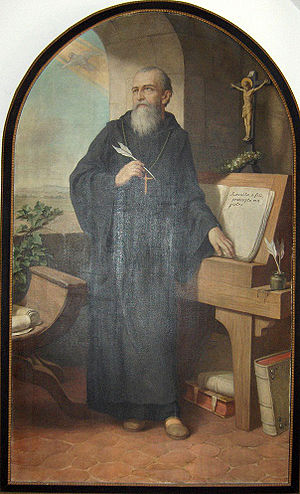
Saint Benedict of Nursia writing his Rule ~a 1929 portrait at Heiligenkreuz Abbey, Austria by Herman Nieg.
L I S T E N carefully, my child, to your master’s
precepts, and incline the ear of your heart (Prov. 4:20). Receive willingly and
carry out effectively your loving father’s advice, that by the labor of
obedience you may return to Him from whom you had departed by the sloth of
disobedience.
be, who are renouncing your own will to do battle under the Lord Christ, the
true King, and are taking up the strong, bright weapons of obedience.
of all, whatever good work you begin to do, beg of Him with most earnest prayer
to perfect it, that He who has now deigned to count us among His children may
not at any time be grieved by our evil deeds. For we must always so serve Him with
the good things He has given us, that He will never as an angry Father
disinherit His children, nor ever as a dread Lord, provoked by our evil actions,
deliver us to everlasting punishment as wicked servants who would not follow
Him to glory.
St Benedict’s Abbey elects Father James Albers 9th abbot
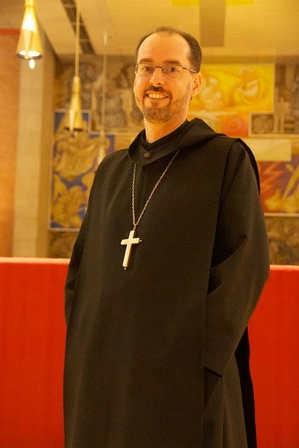 The monastic chapter of Saint Benedict’s Abbey (Atchison, KS) elected Father James Robert Albers, 41 as the 9th abbot earlier today. Until now, he’s served the monastic community as the Prior and vocation director.
The monastic chapter of Saint Benedict’s Abbey (Atchison, KS) elected Father James Robert Albers, 41 as the 9th abbot earlier today. Until now, he’s served the monastic community as the Prior and vocation director.
Kansas monks set to elect new abbot
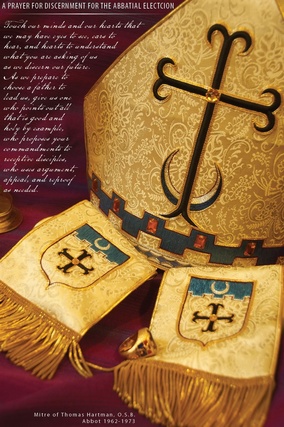 Later today the monks of Saint Benedict’s Abbey
Later today the monks of Saint Benedict’s Abbey
(Atchison, KS) enter into a special chapter (the group of solemnly processed)
to begin the process of electing a new Abbot.
thoughts and prayers as they gather to elect a new Father in Christ.
Holy Spirit guide the hands of the monks. Saint Benedict, pray for the monks.
The New Evangelization and St Benedict
Some Year of Faith initiatives
The monks, nuns and oblates of Saint Mary’s Monastery and Saint Scholastica Priory in Petersham, MA, had a day of reflection on October 20th that covered the New Evangelization and the Benedictine charism. Dr. Philip Zaleski, an Oblate of the monastery and Father Christophe Vuillaume, OSB, a monk at Saint Mary’s gave the two presentations.
Audio files
The Year of Faith and the New Evangelization
Saint Benedict and the Life of Faith
Dr Zaleski is a professor at Smith College and a published author, and Dom Vuilaume is a priest and monk who as served at the request of the Subiaco Congregation in various locations,as of now he’s serving at Saint Mary’s.
The Monastery is celebrating 25 years of foundation this year. The monks belong to the Subiaco Congregation which is one of the largest groupings of monks and nuns in the world. Most often monasteries in the Subiaco Congregation do not engage in outside works and rely on the generosity of others. At Saint Mary’s. the Divine Office is prayed according to the traditional form of the Antiphonale Monasticum; Holy Mass is celebrated according to the Novus Ordo with the ordinary of the Mass prayed in Latin.
The nuns of Saint Scholastica Priory follow a traditional monastic life. They share the monastic church with the monks for some of the prayer times and Mass but have their own work. They were blessed recently to have two novices profess simple vows.

